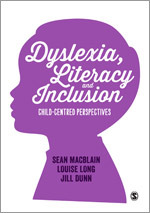Dyslexia, Literacy and Inclusion
Child-centred perspectives
- Sean MacBlain
- Louise Long - St Mary's University College Belfast
- Jill Dunn - Stranmillis University College
This book is about raising standards in literacy for children with dyslexia by putting the child at the centre of everything you do, focusing on wellbeing, and recognising the role that adults have to play in ensuring all children reach their potential. Concentrating on children in primary schools and early years settings the book looks at:
- Early intervention
- Pupil voice
- Working as a team
- New literacies
- Child-centred identification, assessment and provision
- Challenges for the inclusive school.
Suitable for all those working with children with dyslexia this book contains strategies that can be easily adopted to academically and emotionally benefit the children you are working with.
This book is a very valuable resource for a wide range of professionals (including student teachers and teachers) to better address the needs of pupils with dyslexia, including those in the Early Years. The authors give a very detailed examination of dyslexia and the wider issues affecting the pupil, the family and society. Policies influencing the education of dyslexic pupils are discussed, as are major relevant issues such as poverty. Clear real life examples are well used to aid understanding and the structure of each chapter allows the reader to reflect on what they have been reading through exercises, suggestions for further reading and useful websites and video material which are freely available.
The authors have presented a text which will not only assist anyone studying dyslexia but will help professionals to enhance their understanding and professional practice and thereby raise standards in pupils with dyslexia.
I work with both undergraduates and postgraduates and would be very keen to use this highly accessible book within each of the courses. In Wales, of course, the comments on the statutory framework with Early Years would need to be set in the context of our Framework for the Foundation Phase but the sense of the content and the focus on dyslexia would be appropriate to the early years of teaching and learning, regardless of the differing contexts.
This is a clear, concise approach to the discussion on dyslexia and literacy. The child is central to the thinking here; whilst the novice practitioner is given an introduction to the issues, the mature practitioner is challenged to review their outlook and look afresh. I cannot wait for my own copy.
This is a very accessible text that engages the reader in a child centered and holistic issues and approached. It is full of valuable information that professionals (both in preparation and more experienced) will find helpful as they meet the needs of this group of learners in inclusive settings. The literacy focus is particularly important and contributes to our goal of raised standards and high expectations for learners with dyslexia. The perspective of the children themselves is something that raises the quality of the book and a reason why I will recommend it to the teachers I work with!
This is a very important book which offers a refreshingly honest account of the current challenges facing children with dyslexia and developmental literacy difficulties. It acknowledges the conceptual confusion which continues to surround this area, but rightly places an emphasis on understanding the holistic needs of the child in a changing familial and cultural context, and of seeking to meet those needs in a child-friendly, rights-respecting manner. In so doing practitioners are encouraged to appreciate and address the potentially significant emotional impact of dyslexia and literacy difficulties on children, to learn the lessons from the critical reviews of the most recent international research in this field, and to embrace new technologies and popular culture to enhance motivation and self-esteem while offering new learning opportunities. I would thoroughly recommend this book.
This is a well-written book that focuses on early years and the primary sector and provides much information and guidance as well as raising important issues about how dyslexia can be reframed in the 21st Century.
This text is essential to all early years practitioners. It highlights the difficulties and challenges faced in relation to a child's development whilst offering the practitioners a deeper understanding.
Excellent, informative text for students and parents exploring or researching inclusion.
Interesting perspectives on some of the key issues, especially the way in which a child's background affects learning.
Good supplement for teacher trainees and practising teachers. This book covers information about dyslexia and how it affects individuals and their studies. Most importantly this book provides lots of helpful examples and strategies to include in your own practice.
This is a potentially complex set of ideas for students to access, this text manages to be accessible and through







